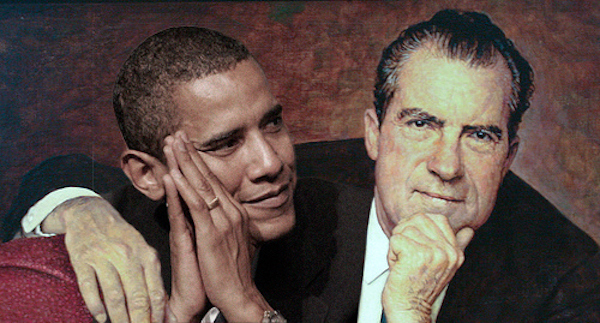This is how the Obama administration would have been able to leave ‘bread crumbs’ leading conveniently to Trump and the Russians. Mind you, there was never any evidence presented. All they needed was speculation fueled by a propaganda campaign led by the Democrats and the media.
When the President saw that his predecessor may have bugged Trump Tower before the election, he took to Twitter early Saturday morning:


Radio host Mark Levin laid out on his show a timeline of events pertaining to the Obama administration’s surveillance of Trump. From Breitbart:
1. June 2016: FISA request. The Obama administration files a request with the Foreign Intelligence Surveillance Court (FISA) to monitor communications involving Donald Trump and several advisers. The request, uncharacteristically, is denied.
2. July: Russia joke. Wikileaks releases emails from the Democratic National Committee that show an effort to prevent Sen. Bernie Sanders (I-VT) from winning the presidential nomination. In a press conference, Donald Trump refers to Hillary Clinton’s own missing emails, joking: “Russia, if you’re listening, I hope you’re able to find the 30,000 e-mails that are missing.” That remark becomes the basis for accusations by Clinton and the media that Trump invited further hacking.
3. October: Podesta emails. In October, Wikileaks releases the emails of Clinton campaign chair John Podesta, rolling out batches every day until the election, creating new mini-scandals. The Clinton campaign blames Trump and the Russians.
4. October: FISA request. The Obama administration submits a new, narrow request to the FISA court which is approved now focused on a computer server in Trump Tower suspected of links to Russian banks. No evidence is found — but the wiretap continued, ostensibly for national security reasons, Andrew McCarthy at National Review later notes. The Obama administration is now monitoring an opposing presidential campaign using the high-tech surveillance powers of the federal intelligence services.
6. January: Obama expands NSA sharing. As Michael Walsh later notes, and as the New York Times reports, the outgoing Obama administration “expanded the power of the National Security Agency to share globally intercepted personal communications with the government’s 16 other intelligence agencies before applying privacy protections.” The new powers, and reduced protections, could make it easier for intelligence on private citizens to be circulated improperly or leaked.
7. January: Times report. The New York Times reports, on the eve of Inauguration Day, that several agencies — the Federal Bureau of Investigation (FBI), the Central Intelligence Agency (CIA), the National Security Agency (NSA) and the Treasury Department are monitoring several associates of the Trump campaign suspected of Russian ties. Other news outlets also report the exisentence of “a multiagency working group to coordinate investigations across the government,” though it is unclear how they found out, since the investigations would have been secret and involved classified information.
8. February: Mike Flynn scandal. Reports emerge that the FBI intercepted a conversation in 2016 between future National Security Adviser Michael Flynn — then a private citizen — and Russian Ambassador Sergey Kislyak. The intercept supposedly was part of routine spying on the ambassador, not monitoring of the Trump campaign. The FBI transcripts reportedly show the two discussing Obama’s newly-imposed sanctions on Russia, though Flynn earlier denied discussing them. Sally Yates, whom Trump would later fire as acting Attorney General for insubordination, is involved in the investigation. In the end, Flynn resigns over having misled Vice President Mike Pence (perhaps inadvertently) about the content of the conversation.
9. February: Times claims extensive Russian contacts. The New York Times cites “four current and former American officials” in reporting that the Trump campaign had “repeated contacts with senior Russian intelligence officials.” The Trump campaign denies the claims — and the Times admits that there is “no evidence” of coordination between the campaign and the Russians. The White House and some congressional Republicans begin to raise questions about illegal intelligence leaks.
10. March: the Washington Post targets Jeff Sessions. The Washington Post reports that Attorney General Jeff Sessions had contact twice with the Russian ambassador during the campaign — once at a Heritage Foundation event and once at a meeting in Sessions’s Senate office. The Post suggests that the two meetings contradict Sessions’s testimony at his confirmation hearings that he had no contacts with the Russians, though in context (not presented by the Post) it was clear he meant in his capacity as a campaign surrogate, and that he was responding to claims in the “dossier” of ongoing contacts. The New York Times, in covering the story, adds that the Obama White House “rushed to preserve” intelligence related to alleged Russian links with the Trump campaign. By “preserve” it really means “disseminate”: officials spread evidence throughout other government agencies “to leave a clear trail of intelligence for government investigators” and perhaps the media as well.
Democrats want every member of Trump’s cabinet and Trump himself investigated for these ‘connections,’ even though there isn’t any probable cause that anything illegal had been done. All they have is conjecture and wishful thinking.
Cross Posted with Eagle Rising




